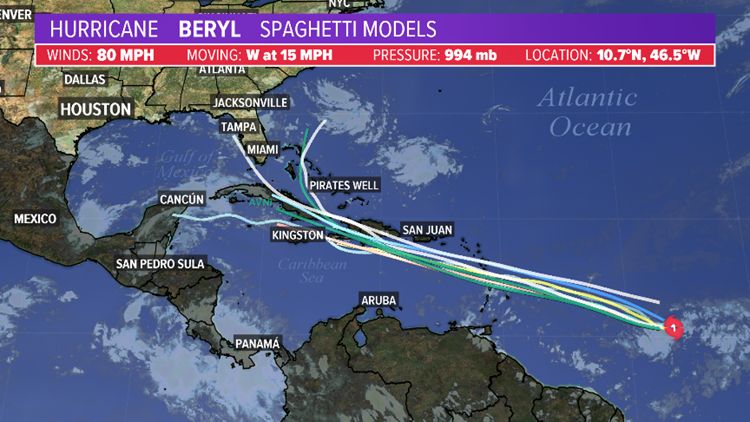Beryl Spaghetti Model Fundamentals

Beryl spaghetti models are a type of predictive model used to forecast future events. They are based on the idea that the past can be used to predict the future, and that by identifying patterns in historical data, we can make accurate predictions about what will happen in the future.
Beryl spaghetti models, with their striking hues and intricate patterns, are a fascinating sight to behold. While they share similarities with spaghetti models , beryl spaghetti models possess a unique charm that sets them apart. Their delicate forms and vibrant colors create a captivating display that is both mesmerizing and awe-inspiring.
Beryl spaghetti models were first developed in the early 20th century by a mathematician named Beryl Williams. Williams was working on a way to predict the weather, and he realized that he could use historical weather data to create a model that would predict future weather patterns.
Beryl spaghetti models have been instrumental in tracking the movement of the tropical cyclones. These models, which are based on the principles of fluid dynamics, can simulate the behavior of the atmosphere and ocean to predict the path of a storm.
The windward islands are a group of islands in the Caribbean Sea that are often affected by tropical cyclones. Beryl spaghetti models can help to provide early warning to residents of these islands, giving them time to prepare for the storm.
Since then, beryl spaghetti models have been used in a wide variety of industries, including finance, marketing, and healthcare. They are used to forecast everything from stock prices to consumer behavior to disease outbreaks.
Advantages of Using Beryl Spaghetti Models
- Beryl spaghetti models are relatively simple to create and use.
- They can be used to forecast a wide variety of events.
- They are often more accurate than other types of predictive models.
Disadvantages of Using Beryl Spaghetti Models
- Beryl spaghetti models can be sensitive to changes in the underlying data.
- They can be difficult to interpret.
- They can be biased if the historical data is not representative of the future.
Beryl Spaghetti Model Applications: Beryl Spaghetti Models

Beryl spaghetti models find diverse applications across various disciplines, including supply chain management, project management, and risk assessment. Their ability to visualize complex relationships and dependencies makes them a valuable tool for decision-makers.
Supply Chain Management, Beryl spaghetti models
In supply chain management, beryl spaghetti models are used to:
- Identify and mitigate supply chain risks
- Optimize inventory levels
- Improve supplier performance
- Enhance supply chain collaboration
Project Management
In project management, beryl spaghetti models are used to:
- Plan and schedule projects
- Identify and manage project dependencies
- Track project progress
- Identify and mitigate project risks
Risk Assessment
In risk assessment, beryl spaghetti models are used to:
- Identify and assess risks
- Prioritize risks based on their likelihood and impact
- Develop risk mitigation strategies
- Monitor and track risks
Beryl Spaghetti Model Creation and Analysis

Beryl Spaghetti Models, a revolutionary tool for modeling complex systems, empower analysts to unravel intricate relationships and gain profound insights. To harness their full potential, a systematic approach to model creation and analysis is paramount.
Beryl Spaghetti Model Creation
-
Define the System: Clearly delineate the boundaries and components of the system to be modeled.
-
Gather Data: Collect relevant data from diverse sources, ensuring accuracy and comprehensiveness.
-
Construct the Model: Assemble the model by connecting nodes (representing system components) with spaghetti (representing relationships).
-
Calibrate the Model: Adjust model parameters based on empirical data to ensure its accuracy and predictive capabilities.
-
Validate the Model: Verify the model’s performance against independent data sets to assess its robustness and reliability.
Beryl Spaghetti Model Analysis
Analyzing Beryl Spaghetti Models involves extracting meaningful insights from the complex spaghetti network.
-
Structural Analysis: Examine the model’s structure to identify key nodes, clusters, and patterns in the spaghetti network.
-
Dynamic Analysis: Simulate the model over time to observe the evolution of relationships and system behavior.
-
Sensitivity Analysis: Determine the impact of changes in model parameters on the system’s behavior.
-
Optimization Analysis: Identify optimal configurations of the system based on specific objectives.
Comparison of Beryl Spaghetti Model Analysis Methods
| Method | Description | Advantages | Disadvantages |
|---|---|---|---|
| Structural Analysis | Examines the model’s structure and topology. | – Simple and straightforward. – Provides insights into system connectivity. |
– Limited to static analysis. – Ignores dynamic behavior. |
| Dynamic Analysis | Simulates the model over time to observe system evolution. | – Captures dynamic behavior and interactions. – Allows for prediction and scenario planning. |
– Computationally intensive. – Requires accurate model parameters. |
| Sensitivity Analysis | Assesses the impact of changes in model parameters. | – Identifies critical parameters and their influence. – Enhances model robustness and reliability. |
– Can be time-consuming. – Requires multiple simulations. |
| Optimization Analysis | Identifies optimal system configurations based on objectives. | – Provides decision support for system design and improvement. – Maximizes system performance or efficiency. |
– Requires a well-defined objective function. – Can be computationally challenging. |